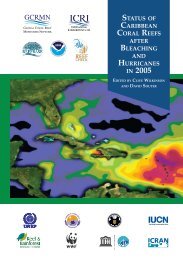Coral Health and Disease in the Pacific: Vision for Action
Coral Health and Disease in the Pacific: Vision for Action
Coral Health and Disease in the Pacific: Vision for Action
Create successful ePaper yourself
Turn your PDF publications into a flip-book with our unique Google optimized e-Paper software.
genomic tools, <strong>in</strong>clud<strong>in</strong>g <strong>the</strong> currently ongo<strong>in</strong>g Nematostella genome project, fur<strong>the</strong>renhances <strong>the</strong> promise of this species. In addition, <strong>the</strong> facility with which Nematostellapopulations can be <strong>in</strong>vestigated with<strong>in</strong> <strong>the</strong>ir natural ecological context suggests that thismodel may be profitably exp<strong>and</strong>ed to address important questions <strong>in</strong> molecular <strong>and</strong>evolutionary ecology. In this review, we explore <strong>the</strong> traits that make Nematostellaexceptionally attractive as a model organism, summarize recent research demonstrat<strong>in</strong>g<strong>the</strong> utility of Nematostella <strong>in</strong> several different contexts, <strong>and</strong> highlight a number ofdevelopments likely to fur<strong>the</strong>r <strong>in</strong>crease that utility <strong>in</strong> <strong>the</strong> near future.”HydrozoansFrank et al. (2001) recommended Hydract<strong>in</strong>ia ech<strong>in</strong>ata <strong>and</strong> H. symbiolongicarpus: “TheCnidaria represent <strong>the</strong> most ancient eumetazoan phylum. Members of this group possesstypical animal cells <strong>and</strong> tissues such as sensory cells, nerve cells, muscle cells <strong>and</strong>epi<strong>the</strong>lia. Due to <strong>the</strong>ir unique phylogenetic position, cnidarians have traditionally beenused as a reference group <strong>in</strong> various comparative studies. We propose <strong>the</strong> colonial mar<strong>in</strong>ehydroid, Hydract<strong>in</strong>ia, as a convenient, versatile plat<strong>for</strong>m <strong>for</strong> basic <strong>and</strong> applied research <strong>in</strong>developmental biology, reproduction, immunology, environmental studies <strong>and</strong> more. Inaddition to be<strong>in</strong>g a typical cnidarian representative, Hydract<strong>in</strong>ia offers many practical<strong>and</strong> <strong>the</strong>oretical advantages: studies that are feasible <strong>in</strong> Hydra like regeneration, patternregulation, <strong>and</strong> cell renewal from stem cells, can be supplemented by genetic analyses<strong>and</strong> classical embryology <strong>in</strong> Hydract<strong>in</strong>ia. Metamorphosis of <strong>the</strong> planula larva ofHydract<strong>in</strong>ia can be used as a model <strong>for</strong> cell activation <strong>and</strong> communication <strong>and</strong> <strong>the</strong>presence of a genetically controlled allorecognition system makes it a suitable model <strong>for</strong>comparative immunology. Most importantly, Hydract<strong>in</strong>ia may be manipulated at mostaspects of its (short) life cycle. It has already been <strong>the</strong> subject of many studies <strong>in</strong> variousdiscipl<strong>in</strong>es, some of which are discussed <strong>in</strong> this essay.”Day <strong>and</strong> Lenhoff (1981), Koizumi (2002) <strong>and</strong> Shimizu <strong>and</strong> Fujisawa (2003) alsorecommended Hydra as a model animal of cnidarians: As a model of developmental neurobiology (Koizumi 2002): “Hydra belongs to <strong>the</strong>class Hydrozoa <strong>in</strong> <strong>the</strong> phylum Cnidaria. Hydra, is a model animal, who’s cellular <strong>and</strong>developmental data are <strong>the</strong> most abundant among cnidarians. The hydra nerve net is amosaic of neural subsets express<strong>in</strong>g a specific neural phenotype. The developmentaldynamics of <strong>the</strong> nerve cells are unique. Neurons are produced cont<strong>in</strong>uously bydifferentiation from <strong>in</strong>terstitial multi-potent stem cells. These neurons arecont<strong>in</strong>uously displaced outwards along with epi<strong>the</strong>lial cells <strong>and</strong> are sloughed off at<strong>the</strong> extremities. However, <strong>the</strong> spatial distribution of each neural subset is ma<strong>in</strong>ta<strong>in</strong>ed.Mechanisms related to <strong>the</strong>se phenomena, i.e., <strong>the</strong> position-dependent changes <strong>in</strong>neural phenotypes, are proposed… By large-scale screen<strong>in</strong>g of peptide signalmolecules, peptide molecules related to nerve-cell differentiation have beenidentified... The neurons <strong>in</strong> <strong>the</strong> nerve r<strong>in</strong>g show little turnover, although nerve cells <strong>in</strong>all o<strong>the</strong>r regions turn over cont<strong>in</strong>uously. These associations <strong>and</strong> quiet dynamics leadme to th<strong>in</strong>k that <strong>the</strong> nerve r<strong>in</strong>g has features similar to those of <strong>the</strong> central nervoussystem <strong>in</strong> higher animals.”288
















